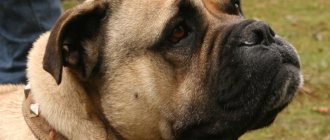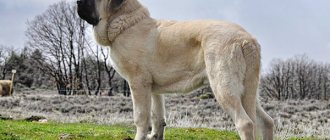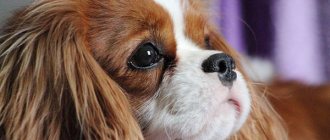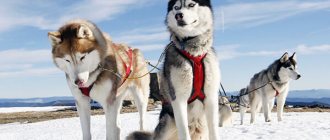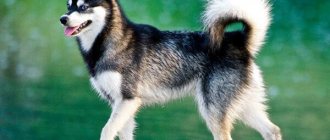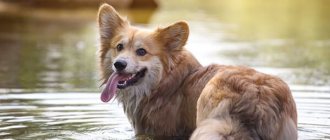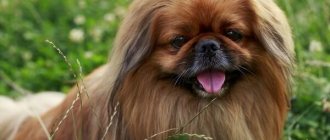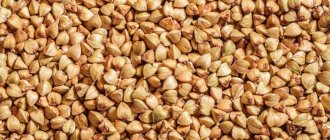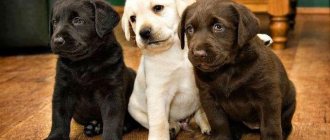Mastiffs are a family of breeds that include Tibetan, Argentinean, Spanish, American, Brazilian, Pakistani, Japanese and other varieties.
The Major Mastiff is a breed of dog with a stable psyche, very balanced and friendly.
She is not at all as evil and bloodthirsty as she is portrayed to be.
Only those representatives who did not undergo socialization and education in time are responsible for such rumors.
In general, the ca-de-bo, although it cannot be called sociable, will easily fit into any family.
In this article you will find a detailed description of this breed, which will help you decide whether it is suitable for you or not.
History of appearance
In the 18th century, Spain was a colony of England. The British brought their own entertainment to the country, one of which was bloody bullfights, which later developed into bullfighting.
At that time, bullfighters had to appear on the field in front of the bull and the dog. But in Mallorca there were no suitable breeds - the herding dogs caused irreparable harm to the bull and there was no show, and the guard dogs were too slow and quickly died.
For this reason, there was a need for baiting dogs. The Old English Bulldog was able to satisfy this need.
Also, the appearance of ca-de-bo is associated with the shepherd ca-de-besti-ara. It is known that bulldogs at that time had a nasty and evil character. It was for this reason that it was decided to cross the breed with “shepherds”, because with the help of this it would be possible to achieve a more balanced dog in character, capable of baiting.
Kadebo began her gladiatorial career, but at the same time she faced a very serious selection process.
Only the female was involved in giving birth to puppies and raising them, and this made the breed an excellent parent. But at the same time, females who experienced problems during childbirth simply died.
Aggression towards the owner was considered unacceptable, and animals that showed it were destroyed.
Also, the mastiff has never been vaccinated. He was unprotected against viral diseases; even after the battle, no one took care of the dogs’ health - they simply died from wounds or diseases. Thus, natural selection allowed only a few representatives of this breed to survive, but these units were the strongest, smartest and most balanced.
By the end of the 19th century, the breed almost disappeared. Only a few dozen Major Mastiffs have survived. To recreate the breed, Ca-de-Bestie-Ara and preserved Old English Bulldogs were again used.
NOTE!
Currently, all problems with breeding Major Mastiffs have been practically eliminated. The vast majority look like purebreds and the very first ca-de-bos.
Interesting facts about the breed:
- The breed also has a second name - Perro Dogo Mallorquin, which literally translates as “bulldog dog from Mallorca”; the name is also known as bull dog;
- During the revival of the breed, breeders paid great attention to the height and size of dogs. Too small indicated a predominance of bulldog genes, and too large indicated a predominance of shepherd genes. Hundreds of puppies were rejected, but those selected could successfully continue to participate in breeding work;
- If you look at a modern Ca de Bou and a photograph of an 18th century Old English Bulldog, you will notice that the Mastiff has much more in common with it than the modern Bulldog.
Origin story
The Ca de Bou dog breed - Major Mastiff - was bred in Mallorca. This is a baiting dog used by Spanish bullfighters to distract the bullfighter's attention. Hence the name - “bull dog”.
For the first time, Perro Dogo Mallorquin appears on the arena at the end of the 17th century. The Spaniards have always been a very temperamental people. After all, bullfighting is their traditional holiday spectacle. Therefore, is it any wonder that they have the honor of creating this unique breed?
Spanish breeders set themselves the task of breeding hardy, strong and courageous dogs.
At the same time, they used not only the method of natural selection.
Achieving the desired result, breeders mercilessly exterminated dogs that did not meet certain requirements.
In particular, a dog that dared to simply bark at its owner had almost zero chance of surviving. But, no matter how barbaric the breeders’ approach may seem, it justified itself.
The Ca de Bou was registered as a separate breed in 1964.
The Ca de Bou became exactly what the breeders intended: strong, strong, fast, brave, and endlessly loyal dogs to their owner.
The first dogs were imported into Russia in 1996. Kadebo did not gain much popularity or distribution.
Description of the breed
Ca-de-bo has a strong build and a slightly elongated body. People who see a Molosser for the first time will be surprised by its extraordinary plasticity and mobility.
The dog has a wide and powerful muzzle, the ears are pink-shaped - they are broken in the cartilage and open the ear canal. The tail is low set and tapers from base to tip. The hind limbs are stronger than the forelimbs. The coat is short, several colors are allowed.
Despite their menacing appearance, the dogs are quite good-natured. They are devoted to their owner and will never show aggression towards him. In the family, they do not single out one person, but give love to everyone in the family indiscriminately.
IMPORTANT!
Despite the docile nature, few beginners can cope with such a serious breed, because it needs an authoritative owner with a strong character.
Character of the ca de bou
Ca de bou have a balanced character. They have no priorities in the family, they do not single out a leader and obey all family members. Infinitely devoted to all family members.
Calm by nature, can be courageous under certain circumstances. Ca de bou is in contact with people, faithful and devoted to the owner. He is careful with strangers, so you should introduce the dog to guests if they come to the house. He is not inclined to fight, he is not a fighting dog, but he will not allow himself to be offended.
In a calm environment, he is self-confident and trusting. When excited, he is piercingly expressive.
Trained to very subtly sense a person’s mood, Perro Dogo Mallorquins empathize with any manifestation of their master’s emotion - be it joy or sadness.
Relationship with children and gets along with other pets
Ca de Bou is a dog that can be trusted to take care of a child. The amazing, unprecedented devotion that was cultivated in representatives of the breed throughout its formation is still one of the undoubted advantages of these dogs. For Ca de Bou, family members and their safety are the meaning of life.
These are very pleasant dogs, friendly to all family members and other pets. Gets along easily with cats and other smaller animals.
Advantages and disadvantages
Representatives of the breed have both positive and negative characteristics. It is advisable to familiarize yourself with them before choosing a pet.
Advantages:
- good learning ability
- Suitable for keeping in apartments and houses,
- not fussy about grooming,
- excellent guard and watchman,
- gets along with children and other pets,
- devotion.
Flaws:
- stubbornness,
- tendency to gain weight,
- requires great physical activity.
Character traits
The Major Mastiff is a very calm and balanced breed , and stories about aggression and anger are associated with the fact that dogs are not socialized in society in a timely manner and do not receive proper education.
The Mastiff does not require much attention. He is quite phlegmatic by temperament, and in the absence of his owner he will simply silently wait for him at the doorstep. When the owner is nearby, the ca-de-bo will happily settle down at his side or near his feet and will look at the person with adoration and devotion.
Despite its friendliness, this breed is not suitable for everyone. She can be willful and stubborn, especially as a puppy during upbringing and training. The Mastiff needs a person with a strong character, who would be internally stronger than the dog. If the dog feels authority, he will be imbued with respect for such an owner and consider him to be the leader and the main thing.
Ca-de-bo has high watchdog and security potential. It is wary of strangers, but will not attack unless there is a direct threat to a family member or territory, and also if the owner does not give a command. The dog will look at the stranger for a long time, expecting a trick, but no more.
The Mastiff loves to play and needs long walks outside as well as some exercise. For example, the animal loves to play frisbee.
Expert opinion
Kozhevin Semyon Kirillovich
Expert dog handler.
“On the surface, the dog appears to be a threat. In fact, properly raised Major Mastiffs have a very restrained character when walking and are difficult to anger. A reaction can occur if the dog feels a real threat from someone or something. Next to family, even children, the dog will be affectionate and calm. They love to be around “their” people. Loneliness is tolerated well, the main thing is to have a favorite toy, food and water nearby.”
Breed characteristics
The unique character qualities of a real Ca de Bou made dogs of this breed an ideal pet for both a city apartment and a country house.
A dog that has no shortcomings, except for its phenomenal stubbornness, has the following advantages:
- Self-control. Traditionally, high fences are not erected in Mallorca; the fence there is a small stone fence, planted with plants such as cacti. A ca de bou can overcome such a fence, but the dogs behave calmly, not paying attention to passers-by. And only encroachment on the owner’s territory leads to an attack on the uninvited guest. The Ca de Bou is a very loyal and active dog.
- Ability to adapt to any circumstances and changes . The psyche and health of ca de bo are not affected by any external influences. The dog takes any changes for granted.
- Loyalty to the owner. Ca de bo are extremely loyal to their owner, ready to serve him until their last breath. A properly raised dog of this breed always keeps the owner in sight to stand up for his protection. Dogs of this breed react to a threat instantly, without warning of an attack, but simply knock the attacker down. Great muscle strength and bone strength allow you to knock down even a strong man.
- The activity of the Ca de Bou is one of the characteristics of the breed. Extraordinary mobility contributes to the proper development of the animal. Ca de bou are almost never too fat, although they love to eat. Long walks and workouts are what is necessary for every step of the way.
Subtleties of training
A characteristic feature of Ca de Bou is their willfulness, which is especially annoying to owners during puberty. Young dogs always want to get their way, whether it's the privilege of sleeping on the couch or the desire to play with the neighbor's dog. The pet turns out to be incredibly persistent, and the owner’s duty is not to give in to the dog.
The innate high ability to learn ca de bou and the mobility of these dogs contribute to the fact that training is successful. To train a pet of this breed, it is important to visit the training area regularly, especially during the transition period.
During the training process, the owner should not treat the dog roughly.
One of the features of the training process with Ca de Bou is the complete absence of rudeness and physical punishment. There is no need to shout or hit a dog of this breed, since in this case trust in the owner is lost. An unusually strong attachment to the owner contributes to the fact that the dog tries to do everything that the owner orders.
Attitude towards children and animals
The Ca de Bou love all family members and are kind and tolerant towards children. Bitches are traditionally softer, due to their developed maternal instinct. But it is undesirable to leave a child alone with a young dog, as children often provoke the animal into aggression by hurting or frightening it.
Pets of all types are not the subject of hunting or aggression, so dogs of this breed get along quite peacefully with cats, birds or rabbits. Living two same-sex dogs in the same territory can lead to rivalry and fights, but the owner is able to prevent conflicts.
Pets of all types are not the subject of hunting or aggression by the ca de bou.
Ca de Bou is usually indifferent to dogs and cats encountered on the street, does not try to start a fight first, but responds to aggression with aggression. The breed does not belong to the category of fighting dogs, but the pet does not need to be artificially baited with other animals, because this may be the reason for the dog’s inappropriate behavior.
IMPORTANT! Ca de bou is not a pet for a beginner. A person who wants to purchase a puppy of this breed must have experience in raising and raising dogs, since it is beginners who leave negative reviews without knowing the features of the Ca de Bou.
Advantages and disadvantages
Advantages:
- Sentry and security potential;
- You can walk without a leash because the dog is not aggressive;
- Loyal to the whole family, has no favorites;
- Loves children;
- Stable psyche;
- Good health;
- Endurance;
- Easy care and unpretentiousness in food;
- No drooling or heavy shedding.
Negative sides:
- Likes to dominate;
- Submits to a person with authority;
- It is very difficult to buy and find a puppy that meets the standard.
Accepted standard
Ka-de-bo has a strong build, a square head, and a furrow on its forehead. The muzzle is cone-shaped, equal to two-thirds the size of the skull. The nose is black, the eyes are large and oval. Can only be dark colors.
The ears are pink.
The Mastiff has a bulldog bite, which is why the bite force of representatives of the breed is strong, and a powerful neck with a slight dewlap.
The body is Molossian, that is, rectangular. The lower back is narrow, the stomach is tucked. The tail is set low and tapers to the tip. The forelimbs are parallel and slightly weaker than the hind limbs.
The coat is short and hard, without undercoat. The dog moves at a trot, alternately rearranging pairs of limbs diagonally.
NOTE!
There are also disqualifying defects: atypical ears, scissor or straight bite, bulldog tail, light iris, undershot, cropped ears or tail, etc.
Training and education
These dogs are easy to train. They are very social and learn communication skills in the first days of their life. Communication with adults works great.
The pet best learns all the restrictions necessary for the owner in the first year of life. The owner's word is law - this must be learned by a serious ca de bou, while receiving praise and mutual understanding.
If people purchasing a Ca de Bou puppy have already had experience in raising dogs, then they will not need the help of a professional dog handler. If not, then they will need to contact a specialist and visit a training site. As a rule, ca de bou easily pass the standards for OKD and ZKS (protective guard service).
The Major Mastiff has well-developed intuition. He easily distinguishes friends from enemies.
In general, training sessions give them pleasure.
Photos with examples of colors
The Major Mastiff can be of the following colors:
- Brindle – dark and light colors are acceptable;
- Red – this includes fawn and fawn. Shades should be saturated;
- Black.
The standard also allows white points as long as they do not occupy more than a third of the body area. Some representatives have a barely noticeable mask.
Breed standard
The appearance of the Cadebo has absorbed all the best features of mastiffs and bulldogs - strong bones, a massive body, a slightly stretched body. Height at the withers for males is 55-58 cm, for females - 52-55 cm, weight - 35-38 and 30-34 kg, respectively. Representatives of the breed have pronounced sexual dimorphism: males have a larger head.
Description of the breed:
- The head is square and massive. The forehead is flat. The back of the head is sloping and wide. The dividing furrow is clearly visible and deep.
- The muzzle is wide, tapering towards the nose, with a sharp stop. Some individuals have folds, like a bulldog.
- The jaws are strong and powerful. Bite with a small snack.
- The upper lips are taut and fleshy. The lower ones form a fold when the mouth is closed.
- The nose is pigmented black and large.
- The eyes are deep and wide set, small, oval, slanting. The eyelids are dense and black. The shell of the eyes is dark.
- The ears are small, rose-shaped, with hard cartilage.
- The body is rectangular, slightly stretched.
- The neck is of moderate length, smoothly blending into the withers. Folds are acceptable.
- The back is strong, wide, convex.
- The sternum is voluminous.
- The limbs are smooth, stable, and muscular. The front ones are widely spaced. The hind legs are more voluminous, the thighs are of medium length, the lower legs are short.
- The paws are oval, the pads are covered with hair, the color of which depends on the base color.
- The tail is powerful, thick at the base, tapering towards the tip.
The coat lies close to the skin, is short, coarse and harsh. The following colors are acceptable: brindle, solid black, red, fawn. There may be white spots, but not more than 30% of the body. Some cadebos have a dark mask on their face, like mastiffs.
Is it suitable for keeping outdoors or in an apartment?
A dog can live equally on the street and in an apartment.
She will be more comfortable in the area, so she can realize her guard instinct. Moreover, the dog will be able to run, which means some part of his need for activity will be fulfilled. The downside is that you will have to bring the dog indoors for the winter. Due to the lack of undercoat, she will not be able to tolerate low temperatures.
In an apartment, a mastiff does not destroy furniture. It is neat, but in this case, you will have to spend a lot of time with your pet outside.
Common features
All purebred Japanese breeds share a similar appearance.
Appearance features:
- wedge-shaped head;
- pointed, set ears;
- curled tail;
- thick coat.
Dogs have a balanced temperament. They are fearless, brave, loyal. They rarely show aggression.
Important! Due to the low population of dogs designated as national treasures, it is almost impossible to export them from Japan.
Does he get along with children and get along with other pets?
The breed gets along very well with children. She loves kids and enjoys spending time with them. The dog is ready to endure various tugging and squeezing for a long time, but the game should always take place under the supervision of adults, no matter how confident you are in your pet.
The mastiff also gets along well with other animals, especially if he grew up next to them. The attitude of a dog that has successfully completed socialization will be lenient.
IMPORTANT!
The dog can be dangerous to children he doesn't know. The Major Mastiff will not tolerate the same attitude from strangers that is acceptable for a domestic child.
How to properly care?
Caring for the ca-de-bo is simple, but must be thorough:
- Brush the coat twice a week using a furminator. This should be done more often during the period of active molting;
- To avoid dog smell, you should, oddly enough, bathe your dog as rarely as possible. Buy shampoos specifically for wire-haired dogs;
- Inspect your ears as often as possible, and wipe them with a cotton swab every 2-3 days;
- Eyes need to be cleaned every week;
- The Ca-de-Beau has a snack, and this contributes to the formation of tartar. Inspect your mouth, and it would also be a good idea to purchase special means for its prevention. Also brush your dog's teeth;
- Nails need to be trimmed as they grow. On average, this procedure is done once a month;
- You need to walk your dog several times a day, for long periods of time, to satisfy its need for physical activity.
Dry food also helps prevent the formation of tartar.
Interesting Facts
- Ca-de-bo needs regular veterinary examination.
- Frequent bathing is harmful to the molosser.
- Puppies require homemade natural food.
- Ka-de-bo loves to play ball.
- The cost for mating is determined by the owner of the dog.
At one American customs office, two dogs of this breed were on duty, which accurately identified drugs in luggage. Mexican drug dealers placed a reward of 30 thousand dollars on their heads. Stories about the bloodthirstiness of the ca-de-bo are the result of improper training of dogs.
Life expectancy and major diseases
The average lifespan of a mastiff is 10-14 years.
The main diseases to which the animal is susceptible:
- Digestive tract sensitivity;
- Possible manifestation of food allergies;
- Dysplasia of the elbow and hip joint;
- Hepatopathy;
- Demodectic mange;
- Myositis;
- Otitis.
Diseases
Kadebos have excellent health. The immunity of dogs has been tempered over centuries. Weak individuals were not cared for, not nursed, not treated, they simply died. Accordingly, only the strongest and most resilient remained, without bad heredity. Thanks to such strict natural selection, Malorsky bulldogs have practically no genetic diseases.
However, it would be wrong to say that cadebos do not get sick at all. Selection work could not but affect the health of dogs, so they still have some genetic pathologies. Thus, the following are often diagnosed:
- myositis - inflammatory damage to skeletal muscles of various origins;
- liver pathologies (cirrhosis and others);
- dysplasia of the hip and elbow joints;
- demodicosis;
- oncology (usually in older individuals).
On average, they live 10-12 years, but there are cases when cadebos lived up to 15.
In order for your dog to live long and happily, you should regularly take him for a routine examination to a veterinary clinic, vaccinate him, and treat him against external and internal parasites.
Future owners should remember that small cadebos should not jump high or walk up stairs - fragile bone tissue is easily damaged under the pressure of a large body weight.
Nutritional Features
Breeders equally recommend both natural food and industrial food. When choosing food for your pet in the store, you need to choose the right brand and quality of food - premium, super premium or holistic.
If you decide to feed natural food, then you need to know:
- The diet should consist of two thirds meat. It should be lean - veal or beef;
- You can give offal, as well as boiled sea fish, but not often;
- Fruits and vegetables will be useful in the diet, but here you need to be careful not to cause allergies;
- You can give eggs, cereals and dairy products.
Fatty, salty, sweet, smoked, pickled, river fish, berries, whole milk, and tubular bones should be completely excluded from the dog’s diet.
NOTE!
Remember that feeding natural food should be accompanied by taking vitamin supplements.
You need to feed twice a day, and the dog should always have access to water.
Features of Japanese breeds
Japanese dogs attract people with their beauty and extraordinary mental abilities.
According to international rules, a country is assigned a breed that was bred by dog handlers on its territory. All dogs recognized as Japanese have similar characteristics.
This is due to the traditional views of the country’s population on beauty, lifestyle, and taste preferences. The traditional traits of Japanese dogs are medium to large in size, although miniature representatives are also found. The dog's body is proportional and harmonious.
Such animals have independence, fearlessness, and balance.
With proper upbringing, they become excellent friends for their owners. Note! Most Japanese breeds are long-lived. Life expectancy reaches 16 years.
Breeds recognized as national treasures are protected by law
Dog training
Successful training can only be achieved with the right approach. If you have little experience, then contact a kennel club, where you and your pet can take special training courses.
You should not encourage your dog to be aggressive, so harsh training methods are not acceptable. On the contrary, you must build a trusting relationship with your pet; remember that the breed cannot be re-educated.
Do not forget that the dog must go through the stage of communication not only with humans, but also with other dogs.
How to choose a puppy?
The first step is to choose the right nursery. Study them carefully and focus only on specialized and confirmed ones.
When choosing a puppy, pay attention to the following:
- The puppy should be 1.5-2 months old;
- A bump on the head - the larger it is, the larger the dog will be in the future;
- There should be no bald spots on the coat, mucous membranes should be free of discharge and odor, and the tail should be free of kinks and deformations;
- A healthy puppy does not show aggression or cowardice. He is moderately curious and playful.
Also check all documents for the puppy and vaccination certificates.
Choose your sex, remember that males are more capricious. It will be more difficult to train and raise them. Females are docile and affectionate, but in the future you will have to face pregnancy and childbirth if you do not sterilize your dog on time.
Types of Japanese dogs
Among the breeds there are representatives with small, large and medium sizes. Therefore, in the standard classification developed by the Society for the Protection of Dog Breeds, it is the dimensions of the animal that are used.
Akita Inu is one of the oldest breeds on Earth
Large
Big doesn't always mean angry and ferocious. This definition directly applies to large-sized Japanese breeds. They are distinguished by self-control, endurance and limitless patience.
- Akita Inu. Akita looks like a teddy bear or a fox. The breed was bred for hunting. Animals are distinguished by their dominant, capricious character. Requires training.
- American Akita. This is a breed developed by crossing an Akita Inu, a German Shepherd and a Mastiff. The breed is distinguished by its calm, kind disposition and strong psyche. Dogs show courage and intelligence. Suitable as watchdogs and service dogs. The maximum height of males at the withers does not exceed 70 centimeters, and weight - 50 kilograms. Due to its unusual color - white and orange, the Akita is sometimes called the red Japanese dog.
- Tosa Inu (Kobudo dog). This is a large guard dog, the only one in this specialization. At the withers reaches 60 centimeters. The breed was obtained by crossing Japanese dogs with mastiffs, St. Bernards and bulldogs. Requires experienced training.
- Kishu. The breed is named after the Kishu Principality on the Kii Peninsula. Also called kishu, kishu-ken. The average height is 50-55 centimeters, weight - no more than 30 kilograms. Dogs have strong immunity and excellent health.
- Kai. A brindle dog designed for hunting. The dogs are calm and strong-willed. Recognized as monogamous. Signs of aggression or excitement are shown only when hunting. They require early education and socialization.
- Hokaido. They are sometimes called Ainu-ken. Initially, the Japanese bred a hunting dog to bait bears. Today, several breed lines are known depending on the breeding area. Dogs are active and inquisitive. They require care and attention. Need walks and physical activity. They cannot stand confined spaces and loneliness. They take training well. Hokaido have a pronounced hunter instinct.
Additional Information! Akita is a fluffy Japanese dog. Its coat consists of three layers: long hair, short hard and soft undercoat. The coat layers are involved in thermoregulation, protecting the dog from overheating or hypothermia.
Medium-sized Japanese dogs are active, agile and agile.
Average
The medium-sized Japanese breeds are diverse. Some representatives are little more than miniature dogs, others reach very respectable sizes. Such animals adapt well both in small apartments and in the countryside.
- Shiba Inu. Small size dog. One of the distinguishing criteria of the breed is the ring tail. Shiba Inus have strong instincts, they need personal space and cannot tolerate other pets. They gained popularity due to their cheerful character, undemanding nature, and charisma. Suitable for dog owners with strong leadership qualities.
- Jomon-shiba. These are strong dogs with an independent disposition. The breed is practically not found in other countries. Height at the withers is up to 40 centimeters. Weight - no more than 10 kilograms. The colors of the Jomon Shiba are predominantly red, white, and multi-colored. Animals have clearly expressed protective qualities.
- Shikoku Inu. In Japan, the breed is called Kochi Inu or Shikoku Inu. Initially bred for hunting deer, wild boar, and guarding. In external parameters it is similar to wolves. At the withers it reaches 45-50 centimeters. Dogs are graceful and quick to react. They are excellent companions, but are only suitable for experienced dog owners, as they are willful.
Jomon-shiba is the work of dog handlers who tried to reproduce the dogs of the Paleolithic era
Small
Small types of Japanese dogs have become more widespread in many countries. They attract dog owners due to their ease of care and cute appearance.
- Japanese Spitz. The height of the Spitz does not exceed 35 centimeters, and the weight ranges from 6 to 8 kilograms. The Japanese Spitz is a dwarf dog. He is distinguished by restraint, taciturnity, increased activity and touchiness. Spitz dogs require frequent walks.
- The Japanese Terrier (Nihon) is a rare smooth-haired breed in Japan. Japanese Terriers are cautious, cheerful, easy-going and very active. They cope well with the role of watchman and hunter.
- The Chin is a Japanese small dog that has its origins in the Pekingese and Spaniel. At the withers it barely reaches 23 centimeters, and its weight is from 2 to 3 kilograms. For a long time they were recognized as the imperial favorites. Japanese dogs have a proud, easy-going character and easy-going disposition. Dog breeders are attracted to them by their small size and long, silky coat. In some individuals it may be slightly curly.
Important! The purebred Japanese Spitz only comes in white. All inclusions are a disqualifying fault.
The Japanese Spitz is a breed that has won the hearts of many dog breeders.
Price range and nurseries in Russia
The price of a Major Mastiff depends on many factors. On average, a puppy costs from 50 thousand rubles. Mixed breeds or defective puppies will cost 10-15 thousand rubles.
The following nurseries of this breed are located in Russia:
- Moonlight Sonata;
- Rus Kauri;
- Alferor;
- Ideal Dogs;
- Miedo Del Toro.
